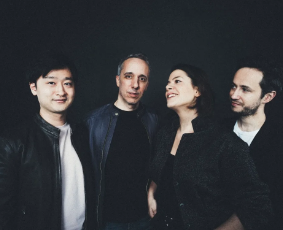Quatuor Ébène; Pierre Colombet Violin 1, Gabriel Le Magadure Violin 2, Marie Chilemme Viola, Okomoto Yūya, Violoncello.
Robert-Schumann-Saal, Row 11, Seat 15.
(This post also appears, in slightly different form, at my Instagram account betweendrafts.)
Unsurprisingly, Quatuor Ébène’s seating arrangement is “European” with the cello outside. Also unsurprisingly, they’re fantastic. They played Mozart’s No.21 D major KV 575; Schnittke’s No.3, and Grieg’s No.1 G minor Op.27. Not exactly risky choices: they’re all popular, i.e., performed regularly, very accessible, and highly enjoyable to play, hear, and watch.
Mozart’s first “Prussian” quartet from 1789, posthumously published in 1791, was commissioned by Friedrich Wilhelm II of Prussia, a skilled cellist. Thus, the cello plays a prominent role in this composition. When Le Magadure announced after the final applause in his adorably French-accented English that this had been the first official concert with their new cellist Okomoto, it became clear that this wasn’t an accidental choice! After the slightest intonation probs in the first bars—so minuscule, however, that I might well have merely imagined them—they excelled in making Mozart sound engaging and natural and light which is incredibly hard. I’m not Mozart’s greatest fan, and I enjoyed the performance immensely.
Schnittke’s polystylistic String Quartet No.3 plays a cherished part in my personal history. Several lifetimes ago on one of our concert tours, when my sense of “awesomely modern” had yet to advance beyond serialism, a very dear friend of mine boomed this piece and Schnittke’s first concerto grosso from his ghetto blaster through our accommodations in the middle of the night, after which I pestered him to play it every night. So that was my gateway drug to post-modernist (postmodern) music!
As for Grieg, the first movement clearly echoes a symphonic mindset (yet not in scope like Schubert’s final string quartet); the second has an intimate soirée and at times even coffeehouse character; the third is a happy potpourri that is mercifully short; and the fourth returns to form with a lot of local color, including some Hardanger fiddle impersonations in the violins (an instrument y’all might know from, e.g., LotR’s Rohan theme, even though it’s not quite played there as it’s supposed to). Grieg, by the way, composed this piece while living in Hardanger. So there!
________________
All Music & Theater Reviews
If you have something valuable to add or some interesting point to discuss, I’ll be looking forward to meeting you at Mastodon!

